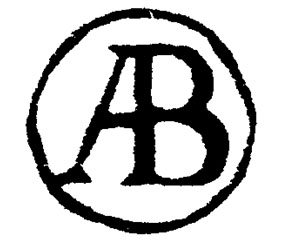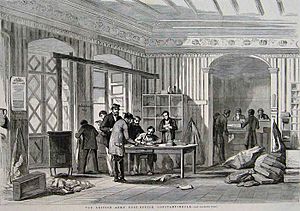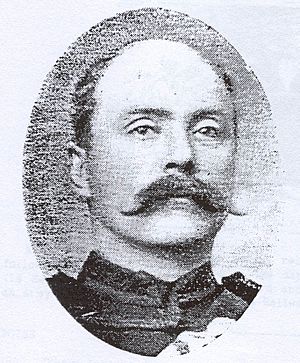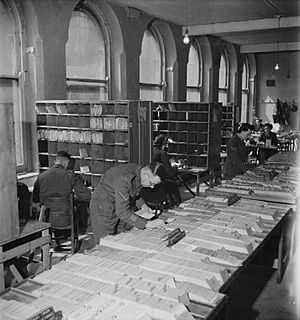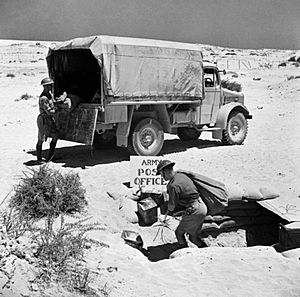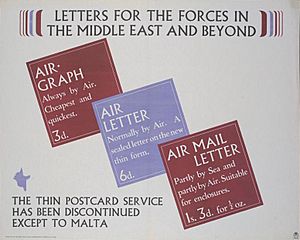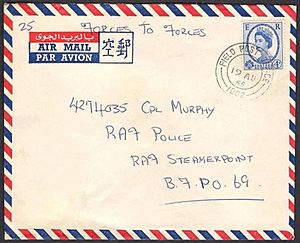History of the British Army postal service facts for kids
The British Army's postal service is now handled by the British Forces Post Office (BFPO). But its history goes way back to ancient times! Imagine, even Saxon kings sent messengers to deliver important news.
Contents
- How Army Mail Started: A Look Back
- Mail During the English Civil War
- Bishop Marks: The First Stamps
- "Common Post" and the War of Spanish Succession
- "Armee Britannique" Post Mark (1743)
- Mail During the Seven Years' War (1756–1763)
- Cheaper Postage for Soldiers (1795)
- Henry Darlot: The Army's First Postmaster
- Mail During the Peninsular War (1809–1813)
- Waterloo Campaign (1815)
- How the Army Influenced Postal Reforms (1840)
- Mail During the Crimean War (1854–1856)
- Forming the Army Post Office Corps (1868–1882)
- APOC in Egypt (1882)
- APOC in Sudan (1885)
- APOC in the Anglo-Boer War (1899–1902)
- Royal Engineers (Postal Section) Formed (1913)
- Royal Engineers (Postal Section) in World War I (1914–1918)
- Royal Engineers (Postal Section) in World War II (1939–1945)
- Home Forces Postal Organization (1939–1945)
- British Expeditionary Force (BEF) 1939–1940
- Middle East Force (MEF) 1940–1945
- British North Africa Force (BNAF) 1942–1943
- Central Mediterranean Force (CMF) – Italy 1943–1945
- India and Far East 1942–1945
- Reconquest of Burma – Mail Airdrops
- Singapore and Postal POWs
- Operation Overlord and the British Liberation Army (BLA), 1944–1945
- Royal Engineers (Postal Section) – Post-War (1945–1993)
How Army Mail Started: A Look Back
The story of army mail began a long time ago, even before the BFPO existed. In Saxon times, kings like Edward the Elder (who ruled from 899 to 924) sent messengers. These messengers would call up soldiers for battle.
Later, in medieval times, kings had special messengers called Nuncii et Cursores. King Edward IV (1461–1483) set up a "Royal Post" to help his soldiers fighting in Scotland. This was one of the first organized postal services for the army.
In 1513, Henry VIII appointed Sir Brian Tuke as "Master of Posts." Tuke made the Royal Posts more formal. He set up regular stops between London and Dover. This helped deliver messages quickly when Henry was fighting in France. Later, during Queen Elizabeth I's time, special mail routes were made for her armies in Ireland and Scotland. A route was even set up in 1588 to carry news about the Spanish Armada.
Mail During the English Civil War
In 1632, King Charles I chose Thomas Witherings to manage foreign mail. Three years later, Witherings suggested a new system. He wanted to send letters quickly between London and all parts of the king's lands. He said this would help defend the country. News of sea fights or attacks would arrive faster.
This led to the creation of the General Post Office (GPO). It was a public service that also helped raise money for the government, including for wars. Witherings set up post offices and routes across the country. Postage was paid by the person receiving the letter. This changed much later, in the 1840s.
During the English Civil wars (1642–1651), both sides had their own mail systems. The Parliamentarians had a "Secret Office" to read intercepted mail. This helped them gather information. Soldiers of the New Model Army even became postmasters. They had to report on their communities. Some parts of this "Secret Office" still exist today.
A famous Royalist messenger was James Hicks. He often passed through enemy lines but was never caught.
Bishop Marks: The First Stamps
In 1660, Colonel Sir Henry Bishop became the Postmaster General. He had fought for the Royalists. As a reward, he was given control of the Post Office.
Bishop started using a metal stamp on every letter. It showed the day the letter arrived at the office. This stopped mail carriers from holding onto letters. These stamps were called "Bishop Marks." They were the first of their kind anywhere in the world. They were the start of the cancellation marks we see on stamps today.
"Common Post" and the War of Spanish Succession
English soldiers fought in the War of the Spanish Succession (1701–1713). They were led by John Churchill, 1st Duke of Marlborough in Europe. Mail was sent using special boats called packet boats. These sailed between Harwich, England, and Hellevoetsluis in the Netherlands.
In Europe, the military mail was handled by the Thurn-und-Taxis Post. This was the postal service of the Holy Roman Empire. It was known as the "Common Post." Later, a service between Dover and Ostend opened.
Marlborough also used the Queen's Messengers. These were members of the Royal household. They carried important messages for the Queen and her ministers. They traveled on horseback and used the official packet services. Today's Defence Couriers in the British Army are like these old Messengers.
"Armee Britannique" Post Mark (1743)
In 1743, a special post mark appeared on letters from British soldiers in Europe. The Thurn-und-Taxis Post handled their mail. They stamped it with a small circle that said "AB" – which meant "Armee Britannique" (British Army).
Mail During the Seven Years' War (1756–1763)
The Seven Years' War was fought in Europe, North America, and India. Mail for soldiers depended on the Post Office Packet Service. Troops in Europe got their mail on packet boats between Harwich and Brielle in Holland.
Mail for soldiers in North America traveled on routes from Falmouth to Halifax or New York. For troops in India, mail was carried on ships belonging to the East India Company. In North America, Benjamin Franklin helped develop the postal system. Mail was often carried by small boats between cities like New York, Boston, and Halifax.
Cheaper Postage for Soldiers (1795)
Soldiers often moved from one place to another in the growing British Empire. This meant their mail had to be redirected many times, costing a lot. So, in 1795, a law was passed to make postage cheaper for soldiers and sailors.
This law allowed soldiers' letters to be sent and received for just one penny. Officers' mail cost six pence. To stop people from cheating, a soldier's name and regiment had to be written on the letter. Their commanding officer also had to sign it. Later, in 1806, a new law added a penalty for cheating. Officers were giving their personal letters to soldiers to send cheaply.
Henry Darlot: The Army's First Postmaster
In 1799, Prince Frederick, Duke of York and Albany, who was in charge of the army, asked for a "good intelligent clerk" from the Post Office. This clerk would help deliver mail and protect money. He was needed for a military trip to Holland.
Henry Darlot, a clerk from the Post Office, was chosen. He became the first official Army Postmaster to go overseas with the army. Mail for the army was sent to the Post Office, sealed in bags, and put on ships to Holland.
When Darlot arrived, he found two mail deliveries had already arrived. It was very messy. He reported that soldiers were very impatient for their letters. Officers would even try to find their letters before the official mail handlers.
The military trip was not successful. Darlot lost his horse and equipment. But when he returned to London, he was praised for his work. His Army Post Office even made a profit of £643 in two months.
Mail During the Peninsular War (1809–1813)
Even after Darlot's success, no Post Office official was sent to help British forces during the Peninsular War. Mail was sent weekly from Falmouth to Lisbon, Portugal. This was a civilian service.
In Lisbon, a British Post Office Agent received the mail. He passed it to the army's headquarters. There, Sergeant R Webb, who was appointed by Arthur Wellesley, 1st Duke of Wellington, sorted the mail. It took 13 to 20 days for mail to travel from London to the battlefield. There was no censorship of mail. The Spanish postal service also helped.
When the army moved into Spain, Major George Scovell became responsible for all army communications. He used cavalry to escort mail. He also ordered that mail bags be returned quickly to headquarters.
After the battle of Vittoria in 1813, Wellington's army moved closer to the Pyrenees. This made mail delivery harder. The postal operations moved to Pasajes, a port in Spain.
Waterloo Campaign (1815)
When Wellington took command of the Allied Armies in 1815, he brought back Lieutenant-Colonel Sir George Scovell to manage military communications.
An Army Post Office was set up in Brussels with two clerks. Mail was sent to and from headquarters through Ostend, Belgium. Army Post Offices continued to operate in France until British troops left in 1817.
How the Army Influenced Postal Reforms (1840)
In 1840, Rowland Hill started big changes at the Post Office. He introduced a single postage rate of one penny. This could be paid using the famous "Penny Black" stamp. This idea was greatly influenced by the cheaper postage rates given to the Army since 1795.
Army officers spoke at a government meeting. Captain J Bentham of the 52nd Regiment said soldiers loved getting letters. He believed cheaper mail helped them a lot. He also said that many soldiers learned to write just so they could send their own letters.
Mail During the Crimean War (1854–1856)
In 1854, British and French troops went to Turkey and Crimea to help the Turks against the Russians. At first, no British Post Office staff were sent. Mail from London went through France to Constantinople (now Istanbul). The French Army Post Office then distributed it to the British Army.
Mail from the British Army went on French boats to Malta. From Malta, it was sent to Southampton, England. This system was expensive and didn't work well. William Howard Russell, a reporter for The Times, wrote that there were always problems with letters. French postmasters would hold hundreds of letters until someone paid a large sum for them.
An officer named Henry Hugh Clifford wrote home that he hadn't heard from England in three months. His letters were held because they didn't have enough stamps.
By May 1854, a new agreement was made with the French. British officers handled the mail in Constantinople. But they had no experience, so letters piled up. The Secretary of State for War received many complaints. The Postmaster General decided to send an "intelligent and experienced Officer" to be the Army Postmaster.
Edward Smith was chosen as Army Postmaster. He left London in June 1854 with an assistant, Thomas Angell. They set up a main Army Post Office in Constantinople. They even used their own money to get the unpaid mail from the French. A month later, Angell set up another Post Office in Varna for the Army Headquarters.
A regular mail service by sea was started between Varna and Constantinople. Later, Angell had to work from a ship because there wasn't enough space on land. He reported that soldiers would rush onto the ship to get their mail, causing chaos.
The mail service faced many problems: not enough staff, no clear shipping info, and bad accommodation. A newspaper, Daily News, reported in January 1855 that the Post Office was "in a pitiful state of hopelessness." It said the two postmasters, Smith and Angell, were not to blame. They were "victims of circumstances."
Soon after, two more assistants and seven sorters were sent from London. One of them, Henry Mellersh, later helped create a dedicated Army Postal Service. Another Army Post Office was set up at Scutari for hospital staff and patients.
First International Money Order Service (1854)
Florence Nightingale asked for a way for soldiers to send money home. This was to help prevent drunkenness. So, the world's first International Money Order Service was created. In its first month, soldiers sent £7,000 home.
Later, Malta and Gibraltar could send money orders. By the end of the decade, Canada started using them. Other parts of the British Empire followed. In 1869, money orders were exchanged with foreign countries like Switzerland and Belgium.
The war ended on March 30, 1856. The Army Post Offices in Varna, Scutari, and Balaklava closed. The main office in Constantinople stayed open. It became the center of British postal service in the area until the First World War.
In November 1854, the Constantinople office was the first outside the UK to use British postage stamps. Mail from there had special "Crown in Stars" or "O*O" cancellation marks.
Forming the Army Post Office Corps (1868–1882)
After the Crimean War, the British Army looked at how to improve mail services for soldiers. Some thought the Army should run its own service. Others thought civilians from the Post Office should do it.
In 1876, the Secretary for War suggested forming a group of volunteers to run the Army's postal services. This idea was given to Lieutenant Colonel John Lowther du Plat Taylor. He was a former private secretary to the Postmaster-General.
A committee was formed in 1877. They recommended that a special corps be created. It would be made of Post Office employees. This corps would set up post offices in the field during wartime. They also suggested a money order service. However, these ideas were put aside for a few years.
In 1881, a rebellion broke out in Egypt. This threatened Britain's route to India through the Suez Canal. An army was sent to stop it. This gave Lieutenant Colonel du Plat Taylor another chance to suggest a postal corps. It was agreed!
Queen Victoria officially created the Army Post Office Corps (APOC) on July 22, 1882. Its members were Post Office employees who were also volunteers.
APOC in Egypt (1882)
Just 17 days after it was formed, the new APOC went on its first overseas trip. Led by Major Sturgeon, they landed in Alexandria, Egypt, on August 19, 1882.
Mail from Britain was sent three times a week through France to Alexandria. The Army Post Offices offered letter and parcel services. They also sold stamps and postal orders. A free parcel service was also set up from Naval docks in England. This was the start of the Military Forwarding Office (MFO) service we have today.
Fixed Army Post Offices were set up in cities like Alexandria and Cairo. Mobile Field Post Offices moved with the army divisions. During the battle of Kassassin on September 9, the Army Post Office came under fire. No one was hurt, but it was the first time these volunteers faced enemy fire.
Major Sturgeon reported to the General of Communications. He sent telegrams about troop movements to help sort mail in London. This practice continues even today, especially for tracking ships.
The mission was a success. The Commander-in-Chief praised the APOC. He said their service was "very successful" and hoped a similar corps would be used again. This happened in 1885 when the APOC went to Sudan.
APOC in Sudan (1885)
The Army Post Office Corps, still led by Major Sturgeon, was sent to Suakin to help the army trying to rescue General Gordon in Khartoum. They arrived on March 27, 1885, and set up the main Army Post Office there. More Field Post Offices opened at other locations.
Mail traveled the same routes as in the 1882 Egyptian Campaign. A daily mail service was set up between Suakin and the army headquarters. A messenger traveled by train with the mail every morning.
The Field Post Offices offered letter and parcel services. They sold stamps and postal orders. Major Sturgeon even started selling embossed envelopes with note paper. This was the first time stationery was sold at Army Post Offices. It was like the early version of the Field Service Post Card used in the First World War. This extra service earned £60.
The mail service was again a success. One soldier wrote that they got their letters very regularly. He said it only took ten days for mail to come all the way from London. He added that everything was "very well managed" when the Post Office Volunteers arrived.
The Army Postal service closed on May 30, 1885. The APOC's services were not needed again until the Anglo-Boer War.
APOC in the Anglo-Boer War (1899–1902)
When the war started, the Army Post Office Corps, led by Major Treble, went to Cape Town. They arrived on September 14, 1899. The main Army Post Office was set up in the new Cape Town Post Office building.
The original plan was to have APOC staff at the main office and along the supply routes. But General Buller decided to attack from two directions. So, the postal services had to be split. A second main Army Post Office was set up in Pietermaritzburg for troops in Natal.
Mail was sent weekly from Britain to Cape Town, taking 14 days. From there, it was sorted and sent to Field Post Offices using civilian postal services. Mail for the Natal army went to East London, then by ship to Durban, and by rail to Pietermaritzburg. This service was sometimes stopped by the Boers.
During the sieges of Ladysmith, Mafeking, and Kimberley, mail piled up. It could not be delivered until the sieges ended.
The APOC created a new way to track soldiers' locations. This was very helpful for both the postal service and army headquarters. Sometimes, mail for sick soldiers was not handled well. To fix this, civilians were hired to keep lists of hospital patients. This way, mail could be sent to them.
During the invasion, mail was sent by train. But it often piled up at stations. This was because of a bad incident at Roodewal Station. On June 7, 1900, Lieutenant Preece and 17 APOC soldiers were at the station when the Boers attacked. They used 2,000 mail bags and other supplies to build defenses. After six hours of fighting, the soldiers had to surrender. Two APOC men were killed, and the rest were captured.
After the surrender, the Boers looted the mail bags. Stamps and postal orders worth £5099 were stolen. One sergeant described the chaos and how they were marched off as prisoners. Some of the stolen postal orders were still being cashed in Britain as late as 1909. In 1914, over 3,000 unused British stamps were found in General De Wet's house.
By August 1900, the war changed. Field Post Offices became fixed Army Post Offices. They got new stamps with the town names. To serve these offices, five Travelling Post Offices (TPOs) were set up. These were Post Offices on railway carriages. The TPO vans were made from large box trucks.
Working on TPOs could be dangerous. One sergeant reported in 1901 that his mail train was derailed and attacked by Boers. He was surrounded by Boers pointing guns at him. Everything was stolen.
By the end of the war, the APOC provided mail service to both soldiers and civilians. Some APOC staff even stayed in South Africa to work for the colonial Post Office.
When the war started, 111 APOC soldiers were deployed. By the end, there were 400. Each week, about 500,000 letters and newspapers and 12,000 parcels were delivered. They also sold £2 million in postal orders and £110,000 in stamps. They helped handle mail for troops from Australia, Canada, India, and New Zealand.
The last Army Post Office closed in October 1902. The last APOC group left South Africa in February 1903. Back in Britain, the staff returned to their normal Post Office jobs. But they kept their military skills by training every September.
Royal Engineers (Postal Section) Formed (1913)
In 1907, a new law meant the GPO had to provide more postal staff for the army. This led to discussions between the GPO and the War Office. They wanted to figure out how the postal and telegraph services could work with the Army.
A committee was formed in 1908. It included members from the War Office and the Royal Engineers. They suggested that the Postal Corps and the Army Signal Service should work together. They believed both services should be part of the Royal Engineers. This would make things more efficient and simpler.
Finally, on February 28, 1913, the Army Post Office Corps joined the Royal Engineers. They became the Royal Engineers, Special Reserve (Postal Section). The first Director Army Postal Service (DAPS) was Lt Col W Price.
The APOC joined the Royal Engineers because the Engineers were interested in electric telegraph systems. The Royal Engineers and GPO had worked together since 1870 to train soldiers in telegraph skills.
Royal Engineers (Postal Section) in World War I (1914–1918)
Overview of Mail Service
During the First World War, the Royal Engineers (Postal Section) (RE (PS)) handled mail for the British Army and later the Royal Air Force (RAF). This service was called the Army Postal Service (APS). Lt Col W. Price, who was the Director Army Postal Service (DAPS) throughout the war, wrote the rules for the APS.
The RE (PS) worked in all war zones. They also worked with the postal services of other countries, like Australia, Canada, India, and New Zealand.
Staffing – Most RE (PS) members came from the General Post Office (GPO). At the start of the war, there were 10 officers and 280 other ranks. By the end of the war, there were about 7,000 staff. From May 1917, women from the Queen Mary's Army Auxiliary Corps (WAAC) also worked at the main Army Post Offices.
Mail Journey – Generally, mail from the UK went to the Home Postal Depot (HPD) in London. There, it was sorted by war zone and army unit. Then, it was sent to ports and loaded onto ships. These ships took the mail to the main Army Post Office (BAPO) in the war zone.
At the BAPO, mail was sorted again. It was then loaded onto supply trains. At the end of the train line, mail was transferred to trucks. Finally, Field Post Office (FPO) staff received the mail and gave it to soldiers' mail handlers. Mail going back home followed the same path in reverse.
Functions – The Base Army Post Office (BAPO) was the main sorting office. It handled all mail between the army, the HPD, and other postal services. It also did other postal tasks. BAPOs were set up in places like France, Greece, Italy, Egypt, and Russia.
Army Post Offices (APO) were fixed offices, usually behind the front lines. Field Post Offices (FPO) were mobile and moved with the forward units. Both APOs and FPOs accepted, sent, and delivered mail. They also sold stamps, postal orders, and War Bonds. They cashed postal orders and handled registered mail.
Home Postal Depot (1914–1920)
The Home Postal Depot (HPD) was created on August 10, 1914. It was first in London, then moved to Reading, and later to Bournemouth. This was to be closer to the war in France and Belgium.
The HPD was the center of the worldwide Army Postal Services. It collected, sorted, and sent military mail. It also recruited and trained staff. In May 1941, it was renamed the Home Postal Centre RE (HPC RE) and moved to Nottingham. It stayed there until 1947.
The HPC RE had many departments. These included letter and parcel sorting, an inquiry branch, and a section for mail to prisoners of war. These were staffed by RE (PS) soldiers, women from the ATS, and civilians.
Heavy tasks, like carrying mail bags, were sometimes done by people who refused to fight in the war due to their beliefs. Trains and trucks carried mail between the HPC, other Post Offices, ports, and airfields.
Finding Lost Mail
Sadly, during wartime, many letters cannot be delivered because soldiers are hurt or killed. In the field, mail that couldn't be delivered was sent back to the Army Post Office. Then it went to the Home Postal Centre (HPC RE).
At the HPC RE, a special branch tried to find the soldiers. If they couldn't, the letter was returned to the sender. Great care was taken to make sure that mail for soldiers killed in action did not arrive before their families received official news.
British Expeditionary Force – France, Belgium (1914–1918)
1914
The APS got its orders to mobilize in July 1914. The first groups of staff left for France on August 11. The main Army Post Office (BAPO) was set up in Le Havre. Field Post Offices (FPOs) were placed with the front-line units. Mail to the UK was accepted from August 15.
During the Retreat from Mons, the FPOs moved back with their units. The main BAPO moved several times. By the time it reached Abbeville, it had moved four times in 50 days. It used trains, horses, and carts.
Once the fighting settled after the Battle of Marne, the BAPO moved back to Le Havre. It stayed there for the rest of the war. A special daily ship service started between Southampton and the BAPO. This cut mail travel time from ten days to four.
More troops arrived from the UK and India. An APO was opened in Marseilles for Indian troops. The retreat and redeployment showed that relying on the supply system for mail was not enough. So, in November, the APS got trucks to move mail between train stations. This made the mail service much better.
King George V visited the army on December 1, 1914. He was happy with the APS's work. For Christmas 1914, the APS added 600 staff and 50 more trucks. They delivered two million letters and half a million parcels without major problems.
On December 28, 1950 (this date seems incorrect, likely 1914), mail bags were destroyed in a train crash. Many "Princess Mary's Gift Boxes" were lost.
1915
The APS kept changing to meet the war's needs. New ship connections were started between Folkestone and Boulogne. A BAPO was set up in Boulogne in January. This cut mail travel time from four days to two.
In April 1915, the Commander-in-Chief, Sir John French, officially praised the postal service. He said a letter posted in London reached the front lines in two days. Parcel delivery was also faster and regular.
As more troops arrived, experienced RE (PS) non-commissioned officers were sent home. They trained new RE (PS) staff for the incoming army divisions.
Royal Engineers (Postal Section) in World War II (1939–1945)
Home Forces Postal Organization (1939–1945)
Home Postal Depot/Centre RE (1939–1945)
The main center for the Army Postal Services was the Home Postal Depot (HPD) RE. It started in London in 1939. Then it moved to Reading, and later to Bournemouth. This was to be closer to the troops in France and Belgium.
The HPD collected, sorted, and sent military mail. It also recruited and trained staff. In May 1941, it was renamed the Home Postal Centre RE (HPC RE) and moved to Nottingham. It stayed there until 1947.
The HPC RE had many departments. These included offices for letters and parcels, an inquiry branch, and a section for mail to prisoners of war. These were staffed by RE (PS) soldiers, women from the ATS, and civilians. Women made up almost half of the 3,000 workers.
Trains and trucks carried mail between the HPC, other Post Offices, ports, and airfields.
Tracing Undeliverable Mail
Sadly, during war, many letters cannot be delivered because soldiers are hurt or killed. Mail that couldn't be delivered was sent back to the Army Post Office. Then it went to the Return Letter Branch (RLB) at HPC RE.
The RLB tried to find the soldiers. If they couldn't, the letter was returned to the sender. If a soldier was killed or missing, great care was taken. Mail was held back until the family received official news.
Army Postal Distribution Centres (APDC) (1940–1945)
After the fall of France, Britain prepared for a German invasion. The Army Postal Service (APS) set up a nationwide mail network. This included the Home Postal Centre and six Army Postal Distribution Centres (APDC) in major cities like London, Bristol, and Edinburgh.
Units collected and delivered their mail to their assigned APDC. This system lasted until the end of the war. A new "Closed" address system was developed. For example, a soldier's address would be "Number, Rank, Name, Unit, c/o APO England." This helped keep troop movements secret, especially before D-Day. This "closed address" idea is still used today by the BFPO.
British Expeditionary Force (BEF) 1939–1940
When war broke out, RE (PS) members were called up. Postal units went to France with their army groups. By mid-September 1939, a main Army Post Office (Base APO) was set up at Cherbourg. Other Army Post Offices were placed along supply routes. Field Post Offices were with the army units.
The APS collected and delivered mail. They sold stamps and telegram services. Mail between the UK and the BEF took 3-4 days. During the "Phoney War" (a quiet period), the APS handled about 9,000 mailbags a day.
Later, the Base APO moved to Le Havre. This cut mail travel time to 2-3 days.
Postal staff and their mail were evacuated from Dunkirk between May 23 and June 6, 1940. One soldier described seeing thousands of men waiting to be evacuated. They carried their cash box with stamps and postal orders. Many were successfully evacuated.
However, some British troops were left in France. A postal officer's diary entries show the confusion. He had to hold mail for some units because their locations were unknown. He also noted that railway communication was interrupted by enemy bombing. Despite the chaos, his unit was eventually evacuated safely from St Malo.
Middle East Force (MEF) 1940–1945
At the start of the war, troops in North Africa and the Middle East used civilian postal services. But by July 1940, a main Army Post Office was set up in Cairo. The Royal Engineers (Postal Section) were allowed to run their own post offices.
Postal units were sent with army groups across North Africa and the Middle East. Some RE (PS) staff were captured at Crete and Tobruk. They spent the rest of the war as Prisoners of War.
Mail routes through the Mediterranean became dangerous when Italy entered the war in 1940. By mid-1941, direct air service to Cairo was cut. New routes had to be found. Surface mail went around the Cape of Good Hope (Africa). An air route was created across the Sahara desert.
These new routes were slower. Mail could take 4-8 weeks to arrive. This affected the morale of soldiers and their families. To make mail lighter for air transport, the "airgraph" and "air letter form" were introduced.
Airgraph
The airgraph was invented in the 1930s to reduce the weight of air mail. Letters were written on special forms, photographed, and sent as tiny negatives on microfilm rolls. A GPO poster said 1,600 letters on film weighed only 5 ounces, while regular letters weighed 50 pounds. At the destination, the negatives were printed and delivered.
In 1940, the idea of using airgraphs for mail between the Middle East and the UK was suggested. The APS and GPO investigated it. In 1941, the service started between England and Egypt. The first batch of 70,000 airgraphs took three weeks to arrive.
Kodak had offices in Cairo that could process the negatives. The APS coordinated the airgraph process in the war zones. Airgraphs were popular, but their small size and lack of privacy meant their use declined when more aircraft were available for regular air letters.
Air Letter
Lieutenant Colonel R. E. Evans RE suggested a lightweight, self-sealing letter card for air mail. It weighed only about a tenth of an ounce. He recommended it to the Secretary of State for War. In January 1941, the service started between the Middle East and the UK. It used flying boats and military planes.
Postage for each air letter was three pence. At first, soldiers were limited to one per month due to limited air space. But later, this limit was removed.
The private nature of the air letter made it very popular. Its lightness led to its continued use as today's civilian air letter (aerogrammes) and the military "bluey."
British North Africa Force (BNAF) 1942–1943
The APS was not involved in the early planning for Operation Torch, the 1942 invasion of North Africa. So, a main Army Post Office was not set up in Algiers until a month after the invasion. Mail services were very poor at first. A convoy carrying Christmas mail was even sunk.
After discussions, air links with the UK were set up. Both air letter and airgraph services became available. Kodak set up an airgraph processing station in Algiers.
In North Africa, mail was carried along the coast by sea, rail, and vehicles. The road service, which covered over 500 miles, was said to be as regular as mail collection in peacetime Britain. A staff officer said, "As soon as the tanks pulled out of battle, there was the mail waiting for them – incredible."
Central Mediterranean Force (CMF) – Italy 1943–1945
Postal units from the Middle East and North Africa went with their armies to invade Sicily and Italy. These were the first big amphibious (land and sea) operations of the war. A postal unit even took a stamp from the Syracuse Post Office on the day of the invasion (July 10, 1943).
Field Post Offices were set up on the beaches during the landings at Salerno and Anzio. Mail leaving Anzio on ships was lost twice due to enemy attacks.
Once the army was secure in Italy, main Army Post Offices were set up in Bari and then Naples. Naples became the main Base APO.
Mail was delivered by truck, train, and air as the army moved north. Surface mail came and went through Naples, Bari, and Taranto. After Paris was freed in August 1944, a more direct air route over France was established. This cut travel time for airmail to Italy and the Far East.
Telegrams from Field Post Offices in Sicily were flown to Cairo. From there, they were sent electronically. Once the main APO was in Naples, telegrams were flown directly to Cairo.
India and Far East 1942–1945
Mail services for troops in the Far East were handled by three groups: the RE (PS), the Indian Army's Welfare Department, and the Indian Army Postal Service (IAPS). This was a difficult working relationship.
Outbound surface mail went by sea from Liverpool to Durban, South Africa. An APS Postal Office was set up there. Then, mail crossed the Indian Ocean to the IAPS Postal Clearing Section in Bombay (now Mumbai). From there, it went to the battlefronts in the Far East.
There was a limited airmail service between India and Britain.
After Singapore fell and the retreat from Burma in 1942, military postal services in India almost stopped. A huge backlog of undeliverable mail piled up in Bombay. People complained in Parliament. The Director Army Postal Services, Brig F Lane, sent Lieutenant Colonel E. G. Hucker RE to investigate.
Hucker suggested reorganizing the IAPS like the British system. This idea was adopted. A main Army Post Office was set up in Calcutta (now Kolkata) by the RE (PS). Mail for British and African troops fighting to retake Burma was sent from there to postal units at supply depots, and then to the front-line Field Post Offices.
Reconquest of Burma – Mail Airdrops
Postal units, led by RE (PS) officers, were formed for the 81st (West African) and 11th (East African) Divisions. They went with their units to the Far East.
The 81st (WA) Division Postal Unit RE, led by Lieutenant AE Tee RE, became pioneers in air-dropping mail to forward Field Post Offices. Special air despatch units were at the main airfields. They packed and loaded mail onto planes. Dedicated mail flights were flown in Dakotas from supply depots. Lieutenant Tee was later promoted and sent to the Chindits to manage their mail. Small evacuation planes were also used to carry mail between front-line FPOs and rear airfields.
On the ground, British and Indian postal services worked closely together. They combined their communication lines to use resources efficiently.
Singapore and Postal POWs
When Singapore fell to the Japanese on February 15, 1942, the entire staff of the 18th Division Postal Unit RE were captured.
While imprisoned, they organized mail service within the Changi gaol and on the 'death' railway work camps in Thailand. The unit's commander, Captain W. A. Border RE, later received an award for this. In 1946, he wrote that the first mail from home arrived after more than a year. The Postal Unit men were allowed to distribute it.
Of the 27 members of the unit, 17 (63%) survived and returned to the UK after the war.
Operation Overlord and the British Liberation Army (BLA), 1944–1945
The APS played a big part in Operation Overlord (the D-Day landings). General Montgomery believed a regular mail service was "the greatest morale factor in an army." It also helped keep the invasion plans secret.
"APO England" and the Deception Plan
After 1940, units in the UK used a "closed address" (e.g., "Number, Rank, Name, Unit, c/o APO England"). This was different from using their normal civilian address.
This address style meant letters were handled by the APS. This provided a simple but effective way to keep troop movements secret. The GPO sent "APO England" mail to the HPC RE. There, it was sorted and sent under military control. This ensured security and hid troop locations. Before the D-Day invasion, all UK units were ordered to use this address style. This "closed address" idea is still part of today's BFPO address system.
Marshalling Areas
Before the invasion, troops were kept in special "marshalling areas." Their only official contact with the outside world was through the camp's Field Post Office (FPO). To keep things secret, all private mail posted at these FPOs was held. It was stored until the news of the landings was made public.
During this time, special trains carried mail from Nottingham to the marshalling areas and ports. Mail was delivered to the assault troops until the day before D-Day (June 5, 1944).
Pre-location Scheme
APS planners knew the full battle plan. Lieutenant Colonel C. R. Smith RE, who was in charge of APS for the Second Army, came up with a "pre-location scheme." This allowed mail to be delivered to different groups of each unit as they landed in Normandy. The scheme used "phantom FPOs." Units were assigned FPOs where they would collect their mail. In reality, they were served by the closest FPO, which the APS considered their "phantom FPO" for tracking.
Normandy Beaches
Field Post Offices were set up on the beaches on D-Day with the assault troops. Mail was planned for delivery on D+1 (June 7, 1944), but it was delivered on D+2 (June 8) due to the invasion's one-day delay.
To get mail safely from ships, a Postal officer used an amphibious Jeep. He would shout through a megaphone at each ship, "Are you carrying mail?" This system was used until the Mulberry Harbours (temporary ports) were built at Arromanches.
The 6th Airborne Division Postal Unit RE and the Beach Group APO S698 made the first mail despatch from Normandy on D+2 (June 8, 1944).
Base Army Post Office 8
The main Base Army Post Office (No 8) arrived on D+10 (June 16, 1944). It set up in a barn at Crepon. The barn had to be cleaned out by bulldozers before the Post Office could start working.
The Base Army Post Office later moved to Brussels, where it stayed until the end of the war. On September 26, the Base Army Post Office closed at Crepon and opened in a large warehouse in Antwerp, Belgium.
On March 8, 1945, the Base Army Post Office in Antwerp was hit by a German V1 flying bomb. Much of the building was destroyed, but only one person was seriously hurt. It was decided to move the Base Army Post Office to Brussels. Women from the ATS who were trained in postal work were sent from Nottingham to help staff it.
Airlifts and Road Service
On July 6, 1944 (D+30), a two-way airlift system started between the UK and airfields in Normandy. It was only for letters and newspapers.
As the British Army moved through France, Belgium, and into Germany, these airlifts continued. They were supported by a detailed system of road routes. These linked the airfields with the main APO and other FPOs. By late 1944, these routes were so punctual that people could set their watches by the arrival of the mail vehicles. This service delivered mail from the UK in 2-3 days.
Once troops crossed the Rhine River, a Postal Despatch Rider Service ran daily. This helped the APS keep up with the fast-changing locations of advancing units.
End of Hostilities in Europe
After Germany surrendered, FPOs were set up in all the main towns of the British zone in Germany. Airmail was flown to various airfields, with Bückeburg becoming the main terminal. Surface mail entered Europe at Calais and was sent by train to the Rhine, then by road.
A base post office was set up in Herford. In 1946, it became the Zone Postal Depot.
Royal Engineers (Postal Section) – Post-War (1945–1993)
The Royal Engineers continued to be responsible for military mail until April 1993. Then, it was transferred to the Royal Logistic Corps. In July 1993, the Defence Postal & Courier Services Agency was created.
Home Postal Depot, Royal Engineers (1945–1993)
The Home Postal Depot continued to operate after World War II. In 1947, it moved from Nottingham to Sutton Coldfield. It took over buildings that had been used by the American UK Postal Depot.


